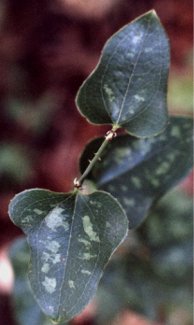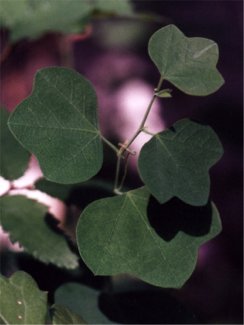Wild Vines
by Valerie (September 2, 2000)

As inhospitable as our climate may seem, there are many plants adapted to it, and when they built our house about 15 years ago, even the bulldozer couldn't eradicate the natural vegetation. When we moved in, there were a couple of trees, a few newly planted shrubs, and bare dirt. We soon discovered that the dirt was but a thin cosmetic layer over a wide variety of rocks set in clay. From this most unlikely base, numerous plants have reappeared and continue to do so in spite of all the landscaping, digging, and planting we do.
While they are persistent, none of these vines are any problem - they grow slowly and are easy to cut off, if not dig out. The only one we eliminated entirely was poison ivy (I'm not allergic to it and think it looks rather pretty, but we would like our gardens to remain socially acceptable). The other vine of which I am not very fond is cat brier, or saw greenbrier (smilax bona-nox). While it looks rather pretty with its spotted leaves, the spines are very painful. However, no matter how far down I dig, the roots of this plant continue, so, like fireants, it is here to stay and must just be dealt with.
Although I try to get accurate identifications on the plants that are illustrated in these articles, sometimes I'm not positive of my information. The next three plants are probably correctly identified, but I'm not totally confident, since some sources showed different characteristics than those here. Ordinary looking wild vines that look a lot like weeds are not the most common plants to be included in many field guides.
A really beautiful foliage plant, peppervine (Ampelopsis arborea) grows in abundance in all our shady gardens. I've never seen them bloom or produce fruit, but I also have to cut them back periodically because they will overgrow other plants. The leaves are a deep bluish green and always look pristine, without insect or disease damage. The stems are stiff and reddish in color. This particular vine spreads very fast underground and is constantly sending up new shoots.
We have one specimen of snailseed vine (Cocculus carolinus), near a large oak tree in our neighbor's yard. This plant is also called Carolina coralbead and redberry moonseed and the leaves resemble ivy. It is another of those vines that can completely cover a shrub or tree, but often it just grows amongst the undergrowth in forests. Even though it has been growing relatively unmolested for at least a decade, it has not produced flowers or berries, but continues to grow larger each year. With all these native vines, it might be surmised that we would not need to plant any other ground covers, but, in our enjoyment of variety, we also have a full compliment of various ivies and creepers. |




